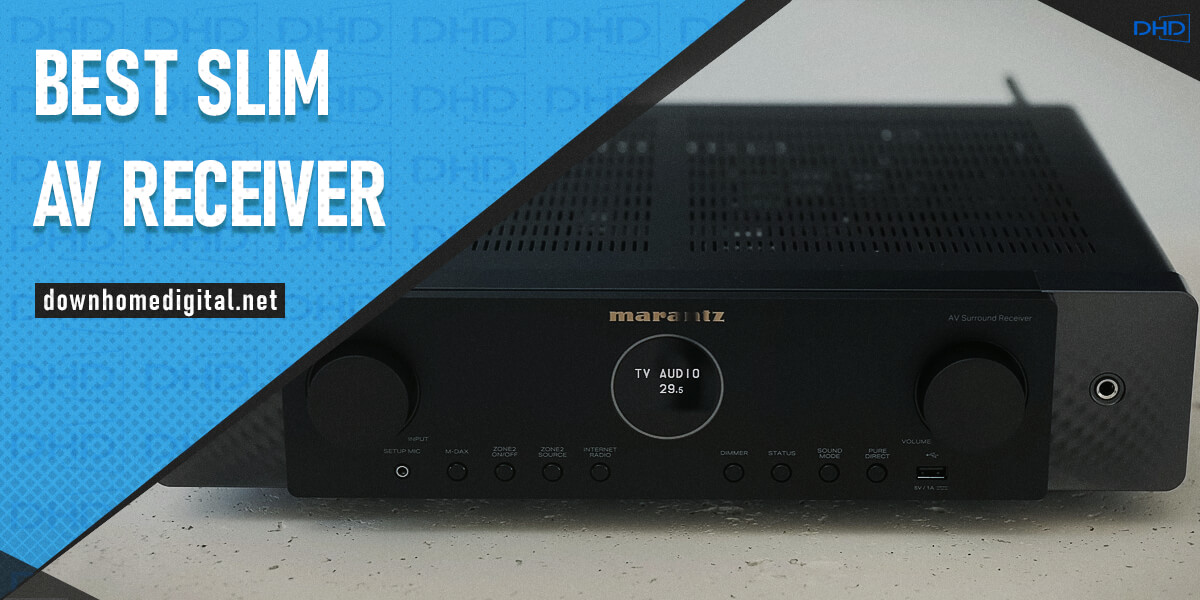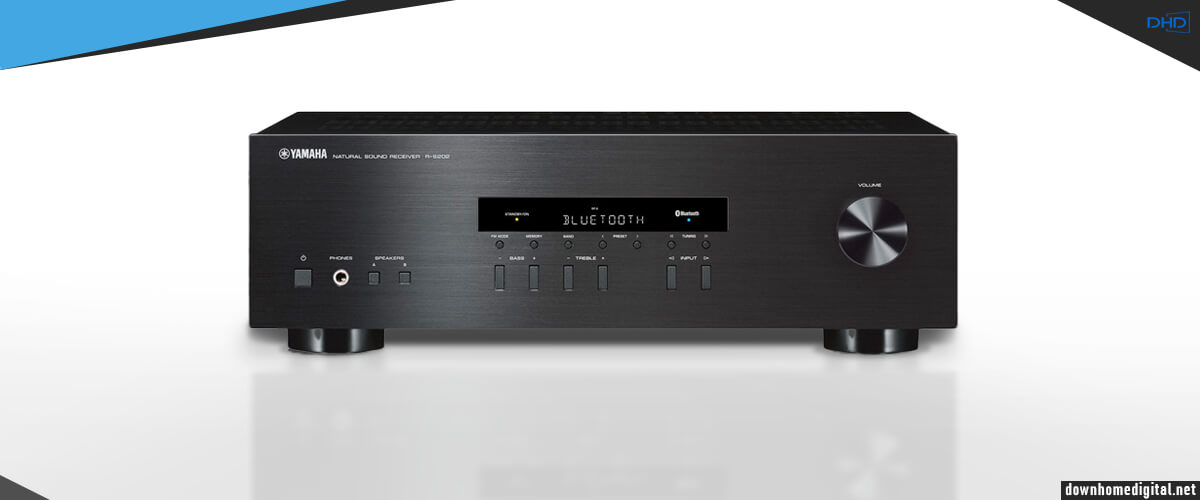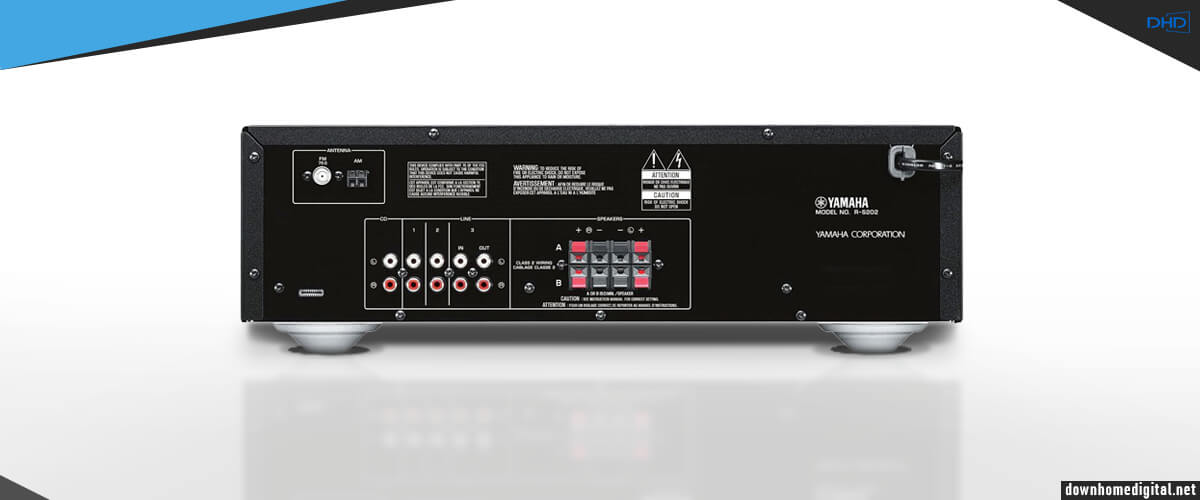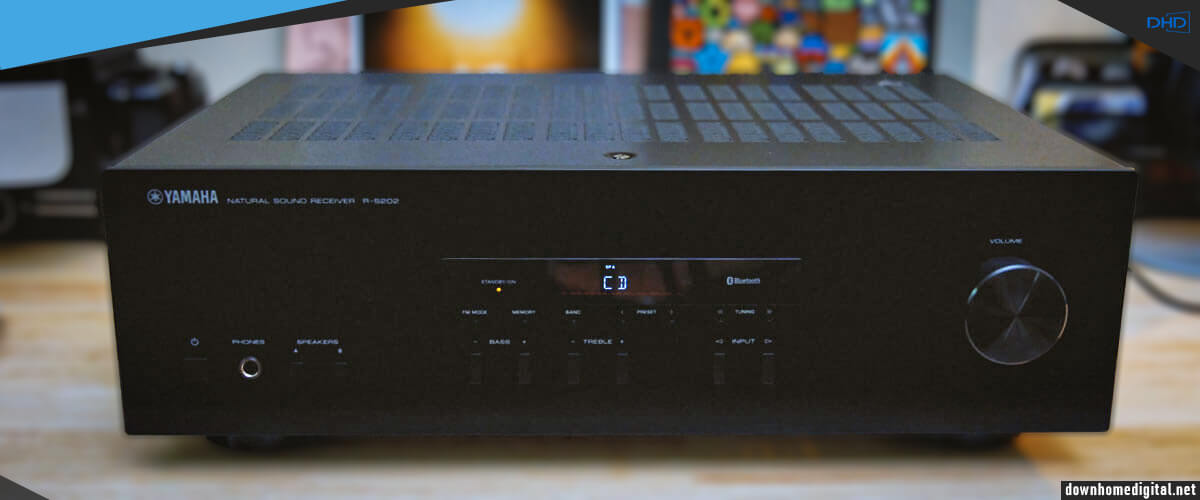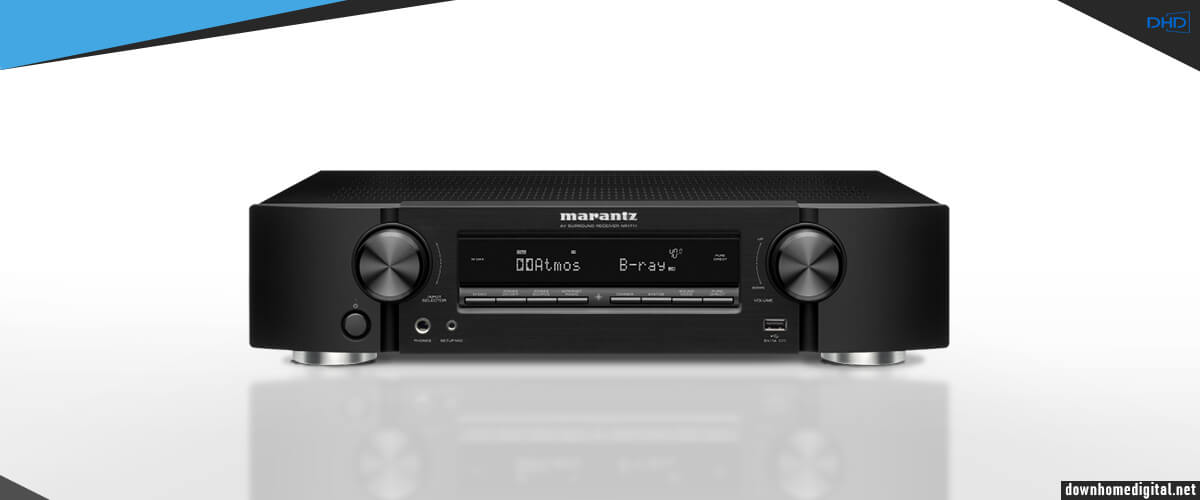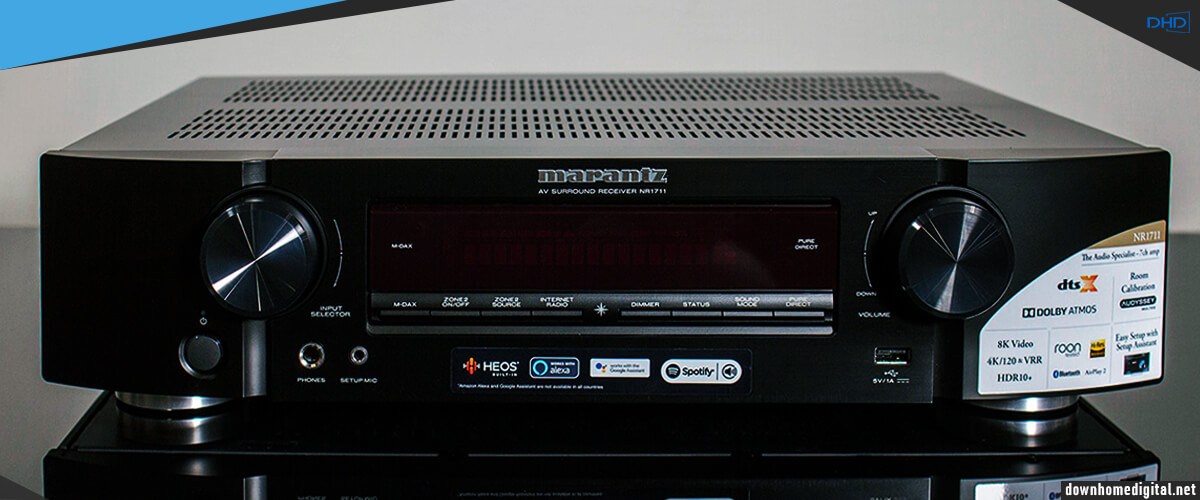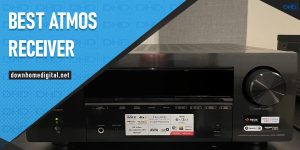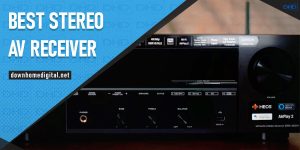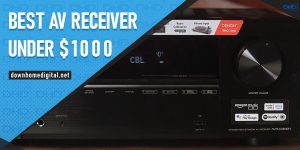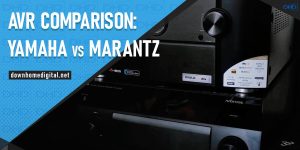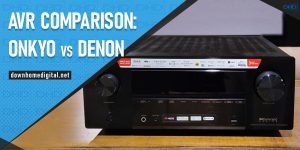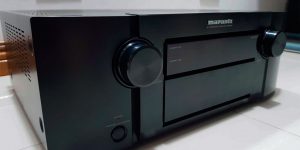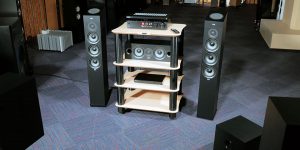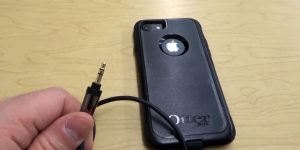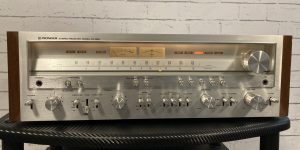Choosing the best slim AV receiver is no easy task, especially if you barely understand what all those ports, features, and buttons are needed for. Since slim AVRs differ from larger counterparts, you may feel even more confused when picking the most suitable option.
I have studied current offers back to forth to provide you with the most important information in this review. In general, people looking for mini AV receivers have a limited space where they can locate such a device, and they often forget about the importance of its sound-emitting capabilities. That’s a huge mistake that can become a sore point in the future. I believe that there is nothing more important than the quality and richness of the sound produced when it comes to receivers in general.
To help you grasp how to get a perfect model for your money, I have meticulously described the most important parameters you need to keep in mind. From the number of channels and power output to the wireless connection and dedicated control apps – this is just a glimpse of what you can find in my review.
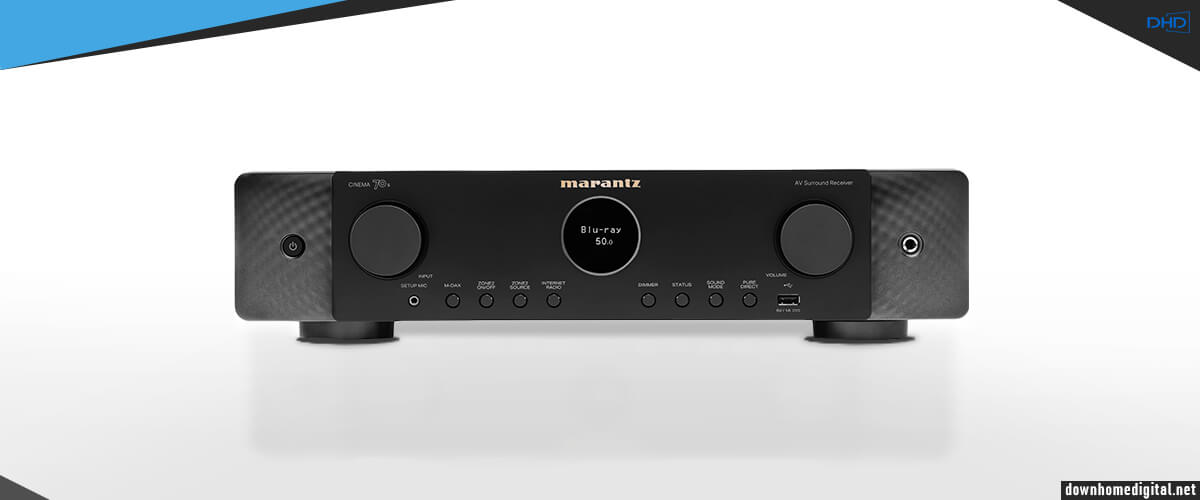
Slim receivers comparison table
| Name | Channels | Power output | HDMI in/out | Bluetooth/Wi-Fi | Review |
|---|---|---|---|---|---|
| Marantz Cinema 70S best overall | 7.2 | 50W/8 Ohm, 70W/6 Ohm | 6/1 | yes/yes | Review |
| Sony STR-DH590 slim AVR | 5.2 | 145W/6 Ohm | 4/1 | yes/no | Review |
| Marantz NR1200 stereo | 2.0 | 75W/8 Ohm, 100W/6 Ohm | 5/1 | yes/yes | Review |
Which slim receiver to choose: stereo or surround sound
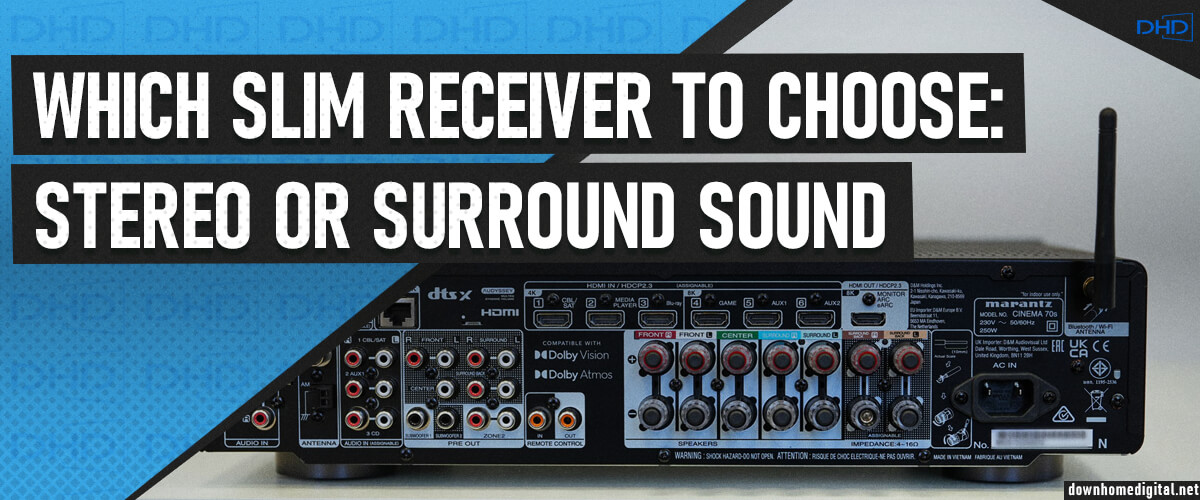
While searching for the best small receiver, you are likely to bump into 2 separate categories of products – home theater receivers and stereo receivers. Both types of devices can nicely level up your media consumption experience, but each in a different way. Some users rush to purchase both systems, but you need to learn the peculiarities of each unit to avoid needless expenses.
Home theater receivers are specifically optimized for surround sound and video content, but most of them can also work in a 2-channel stereo mode. Once you activate this mode, you can use a device to listen to music with high clarity and crispness. When a home theater receiver is used as a substitute for a stereo device, only the front left and right speakers, and a sub, are active. In all other cases, there are at least 3 speakers you can take advantage of.
If you are an audiophile and need a receiver solely for music listening or want a hub for the second room, then getting a stereo system is a smart thing to do. Though such a device is deprived of video extras and some advanced features, it can reveal its sounding potential in full glory, especially when paired with a set of top-notch loudspeakers.
Whether you decide on a stereo receiver or the one capable of outputting surround sound, you must understand that they differ depending on the brand and the model. The main distinction lies in the range of features. If you look for a receiver in a brick-and-mortar shop, you can ask for a listening demo to understand what boost a device can add to your current audio system. If you are doing online shopping, this possibility is absent, and you need to trust the specs.
Pay attention to the heating of the slim receivers
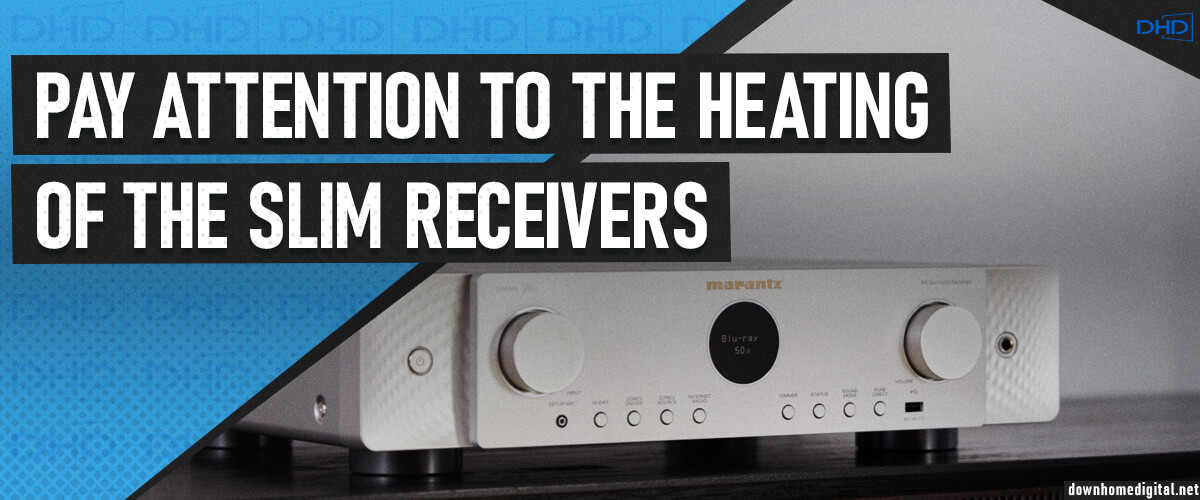
The main reason why people buy compact receivers is that they occupy very little space if compared to standard-sized systems. It is common to locate such a device in restricted areas, embed it into shelves, place it among tight furniture pieces, etc. It seems like a great space-saving decision, but there may arise a serious problem – overheating.
When a receiver keeps running in a confined space for a long time, it will inevitably overheat no matter how elaborate its original cooling system is. If you want to prolong the service life of your small device, you need to do all possible to dissipate the emitted heat.
Some users decide to buy a stock cooling system, but this is the minimum you can do. A good rule of thumb is to place your receiver in the area where its parts responsible for “exhaling” heat won’t be closed by walls, shelves, etc. This way, you can expect natural ventilation.
The latest low-profile AV receivers are designed with overheating problems in mind, so they are equipped with sensors that automatically shut off your electronics if it starts operating at high temperatures. Unfortunately, wallet-friendly devices don’t have such sensors, so you need to keep tabs on how hot they get yourself. Just check your receiver from time to time to avoid overheating.
If you treat your device with the utmost care, it will reward you with many years of trouble-free operation.
How I picked and tested compact receivers
I was determined to find a high-quality small surround sound AV receiver and a good stereo receiver so that you can feel every tremble and sound shift while listening to music or watching movies.
To evaluate the quality of surround sound in video, I watched John Wick 3. First of all, I am a fan of this film (I think like millions of movie lovers), and secondly, this movie has a lot of action scenes, special effects, and talks. So it’s perfect for testing it out.
To check whether receivers are equally efficient with audio, I listened to tracks in different genres and from varied sources.
- Bob Marley & The Wailers – Turn Your Lights Down Low – Deezer
- Arctic Monkeys – Do I Wanna Know – SoundCloud
- Radiohead – The National Anthem – Spotify
- The Weeknd – The Hills (CD player)
- Mahler – Symphony No.2 (CD player)
- Led Zeppelin – Ramble On (CD player)
- Jacky Terrasson – Reach (CD player)
- Mark Nauseef – With Space in Mind (CD player)
My toolset for tests consists of:
-
- CD player SACD 30n
- Blu-ray player Sony UBP-X700
- Speaker wire – AudioQuest Type-9
- Speakers for the movie – Klipsch RP-8060FA (used 5.1)
- Stereo speakers:
- Klipsch RP-8060FA
- KEF Q350
- DALI OBERON 5
- Klipsch RP-600M II
Best compact surround sound receivers
Marantz Cinema 70S – best overall

And the winner of this selection is the only 7-channel model of 2022 – Marantz CINEMA 70s. It replaced the Marantz NR1711 in the brand’s lineup (you’ll find it in the Discontinued Models section), but its parameters resemble its predecessor in many ways. The device’s dimensions are almost identical: 17.4 x 15.1 x 4.3 inches/43.18 x 38.1 x 10.16 centimeters.
When it comes to a narrow-body receiver, you must realize that the components inside the chassis are very close to each other, automatically creating interference and the threat of overheating. So I’m in complete solidarity with Marantz in that they’ve stated a power rating of 50 watts (8 ohms, 20Hz – 20kHz, 0.08%, 2ch, this will save you from additional ventilation, as the Cinema 70s hardly ever overheats during prolonged use. But, of course, this is the smallest power output for a 7-channel unit. With standard receivers, it is always higher.
Regarding the construction, the design of the CINEMA 70s should also be mentioned. The new line from Marantz is characterized by a very nice but completely uninformative (due to the size and dimness) LCD round shape on the body. I understand the idea, but it’s more of a decorative element than an important one. I’m also not crazy about the little round buttons on the front panel. If you have large fingers (like yours truly), you will feel like a clumsy bear with a crystal flower in your hands (okay, I’m exaggerating, but you get the point). Other than that, of course, I have no complaints about Marantz. They always pay attention to the quality and the weight of the case because the anti-resonance of the device depends on it.

As for video functions, CINEMA 70s is the absolute leader in my selection. It has the largest number of HDMI ports, version 2.1 (3 out of 6), equipped with HDCP 2.3, CES, eARC, gamer stuff, and, of course, broadcast 8K video. But the output is only 1, as are indeed all the other selection participants. Generally, it’s quite expected for a receiver to have the word “cinema” in its name.
So, we have figured out this is a universal device regarding “picture”. But you know what? It’s also completely flexible in sound. I really liked the way it broadcasts music in stereo. This applies both to vinyl (where Marantz’s warm, realistic sound is just right) and to digital sources. Apple compatibility was a pleasure. In fact, everything works at a very high level; the signal is not lost and does not sag. To avoid spreading the description on half a page, I just say that music lovers can be calm. Since I tested a lot of receivers, I can confidently say that CINEMA 70s significantly surpasses its competitors not only in this selection but also in the market in general.
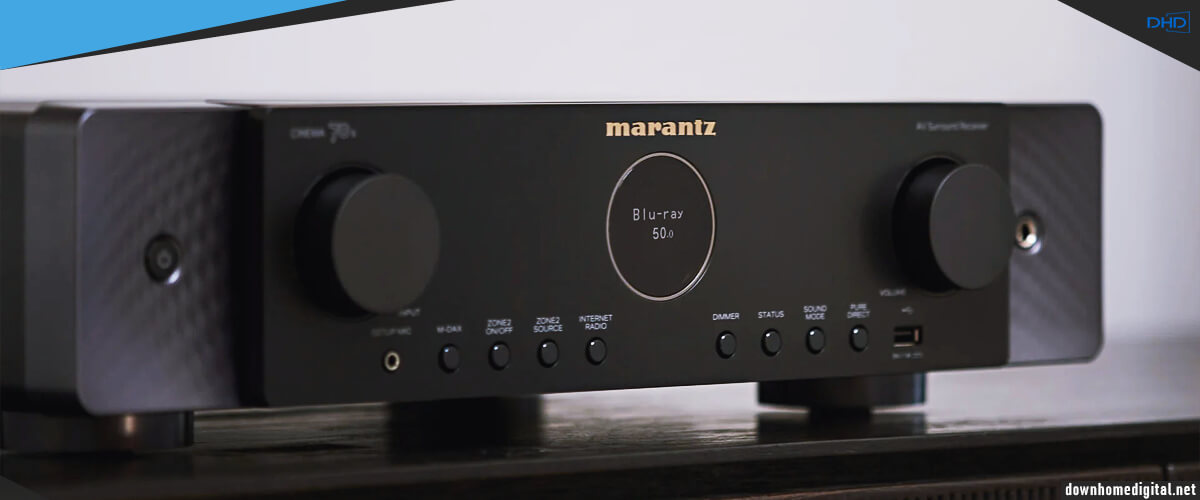
Small receivers – small speakers! Given the receiver’s power capabilities, it is quite enough to have shelf speakers, and I would like to recommend a very specific pair of Klipsch RP-600M II. At any volume, they are sensitive enough to recognize and not lose nuances, highlight vocals with brightness, and provide very decent bass. I mounted them on stands by the TV and was pleasantly surprised at how they filled the space with dense, layered sound. Combined with the warmth and dynamics of the CINEMA 70s, it sounds just great, butter to the ears.
Actually, it’s left to tell about the surround sound. And let me say right away that all my enthusiastic epithets are fair if you understand exactly what the AVR under consideration is capable of. Let me repeat – this is a low-power receiver. In a 5.2.2 configuration (exactly with two subs) and in a small room (one of my studios is 220 square feet), the Cinema 70s sounds simply gorgeous. But don’t expect it to shake the air. When watching Thor: Ragnarok in Dolby Atmos and DTS:X (I tried both modes), the sound was even and balanced in every corner, and I heard every nuance: when Thor’s glass filled with beer when he was visiting Dr. Strange or when the Bifrost Bridge shattered into splinters, the receiver didn’t miss a single nuance, and the picture was synchronized perfectly. And if you’re not a fan of complicated settings, Audyssey MultEQ will automatically calibrate the system to suit most users. There’s a reason it’s considered the most optimal among the standard ones.
Marantz CINEMA 70s – the most expensive in the list, the only one with 7 channels, and therefore with Dolby Atmos. This universal receiver perfectly fits and copes with movies with surround sound, stereo, and consoles. Despite the low power – this is the best slim AV receiver because the manufacturer just honestly said, “For super-quality sound, signal transmission is no longer needed; otherwise, the device will overheat, and interference will be heard.” Many modern features are necessary for the modern user, such as multi-room system HEOS, compatibility with Apple devices, and AVR, which will not need to be updated for a long time. But most importantly, neither in this ranking nor among other receivers with an identical price (even some standard-sized ones) will you find such high quality, warm, even, and balanced sound.
| Power |
|
| HDMI features |
|
| Video features |
|
| Network |
|
| Surround sound processing |
|
Pros
- This is the only 7.2-channel receiver in my rating (not counting the discontinued Marantz NR1711).
- The CINEMA 70s doesn’t overheat when operated for long periods.
- 3 of the 6 HDMI ports are version 2.1.
- High compatibility with Apple devices.
- Versatile receiver for movies, gaming, and stereo (including vinyl).
- Audyssey MultEQ is incredibly simple and perfectly adapts the sound without manual intervention.
Cons
- There isn’t a lot of power for a 7-channel receiver, but that’s due to the size.
- Small LCD and awkward control buttons on the front panel.
Sony STR-DH590

Since the 80s of the 20th century, Sony has focused on the production of audio equipment, trying to cater to the needs of avid audiophiles. Such hard work is generously rewarded by many satisfied buyers and their complimentary reviews. Anyway, I was determined to check whether their products can live up to their reputation, and I chose Sony STR-DH590 for my test. At once, it should be noted that since the cost of this model is 4 times less than the selection leader, we will talk about the budget variant of the rating, not an alternative.
Even externally, the receiver looks very simple, but do not be too strict. The model was released in 2014, which is why it is low price. Nevertheless, the STR-DH590 housing is not as high-quality as the selection leader and overheats a lot when operating at high power. That’s why the receiver goes into “Protective Mode” automatically every time the volume increases. Here’s an explanation of why Marantz immediately made its slim receiver low-powered. Buttons are pressed with a distinctive click, and the controls are a bit unstable, so I’m sure the whole thing will eventually loosen up and become annoying (if not fall off). That being said, the remote is also outdated and unsightly, like it was designed in the last century. But all this can be covered a little because you can afford to buy such a receiver every half a year. Much more important is how it sounds.

The first thing I noticed is that the unit is even smaller than Marantz CINEMA 70s, so if you have a very tight space for your receiver, it may be an ideal option. The real dimensions are 17 x 5.1 x 11.7 inches /43 x 13.3 x 30 cm. Another difference is the number of channels. While the first model can be used as the core of a 7.2-channel system with native Dolby Atmos sound, this receiver has only 5 channels.
The power output of each channel is 145 W at 6 Ohms, and the distortion doesn’t exceed 0.9%. You can use a total of 4 HDMI inputs and 1 output, 4 analog and 1 optical audio inputs, ports for connecting a game console, TV, Blue-Ray player, and headphones. This is the smallest number of HDMI ports in my selection, and all of them are for 4K video only. Plus, I couldn’t use ARC and optical channels on independent channels. All in all, everything feels dated and behind modern requirements.

Let’s just say I was impressed with the sound (both when watching a movie and listening to songs) with no echo or false tones, but only up to a certain volume level. You don’t have to rely on the data written in the spec sheet; just accept that it won’t be too loud (otherwise, it’s interference). The setup is, of course, very simple, using a calibration microphone, but for 5 channels, this is, in principle, enough. However, the volume of each individual speaker cannot be adjusted. Nevertheless, the middle speakers are impressed with the purity and clarity of sound, and the night mode further clarifies the voices. In general, for a receiver at the price of an ordinary boombox, those are just amazing results. But in the case of STR-DH590, I can’t guarantee that the system will sound the same in a few years. Here, we are dealing with the basic surround sound formats DSD, Dolby Digital, Dolby Dual Mono, and DTS-HD High-Resolution Audio. In all of them, the receiver showed itself very well; the sound was not mixed, but I can’t talk about any peculiarities of the soundstage. It’s definitely better than your TV’s sound, plus surround sound – in my opinion, it’s enough for such money.
Sony STR-DH590 is a great budget compact home theater receiver for those who want surround sound in their home without spending almost anything. This is its only ability, not counting the Bluetooth function and the ability to connect a CD player. No frills, easy to set up and use, it doesn’t just resemble the tech of my youth, it practically is. There’s no Wi-Fi, the receiver only handles 4K video and very few connections, and you can’t even separately set up speakers for a 5-channel system.
In fact, after overpaying a couple hundred bucks, it won’t be hard to find an alternative. But for its money, it does a good job of doing what it’s designed to do.
| Power |
|
| HDMI features |
|
| Video features |
|
| Network |
|
| Surround sound processing |
|
| Channels | 5.2 |
| Stereo power (RMS), W/Ohm | 145/6 |
| Output impedance, Ohm | 6 |
| Frequency response | 10Hz-100KHz |
| THD in stereo, % | 0.09 |
| Digital to analog converter (DAC) | 192 KHz/32-bit |
| Bi-amping | no |
| Pure direct (straight) | yes |
| Auto speaker calibration | DCAC |
| Speaker A/B switching | no |
| Other audio features | has not |
| Wi-Fi | no |
| USB | 1 (USB 2.0) |
| Bluetooth | yes |
| Ethernet (RJ45) | no |
| DLNA | no |
| MHL | no |
| Apple Music (AirPlay) | no |
| Amazon Music | no |
| Spotify | no |
| Other streaming services | has not |
| HDMI input/output | 4/1 |
| HDMI ARC (Audio Return Channel) | yes |
| HDMI eARC (Enhanced Audio Return Channel) | no |
| HDMI CEC | yes |
| Digital content protection (HDCP) | HDCP 2.2 |
| Subwoofer output (LFE) | 2 |
| Headphone output | 1 x 6.3 |
| Optical digital input | 1 |
| Coaxial digital input | 1 |
| Composite input | 0 |
| Component input/output | 0/0 |
| Phono (MM) input | no |
| Front panel connectors | phones, setup mic |
| Multi channel preamp output | no |
| HDR (High Dynamic Range) | HDR10 |
| 4K signal pass-through | 4K/60Hz |
| 8K signal pass-through | no |
| HDMI signal pass-through | yes |
| 3D signal pass-through | no |
| HDMI pass-through in standby mode | yes |
| Video conversion | no |
| Analog to HDMI scaling | no |
| HDMI to HDMI scaling | no |
| Dolby Vision | yes |
| Other video features | HLG |
| Voice control | no |
| App control | no |
| Display | fluorescent |
| Tuner | AM, FM |
| Sleep timer | yes |
| Auto power off | no |
| ECO mode | no |
| Graphical user interface (GUI) | no |
| Setup assistant | no |
| Firmware update | USB |
| Other additional features | has not |
| Multi-room zones | has not |
| Zone audio output | has not |
| Zone HDMI output | has not |
| Multi-room control | has not |
| RS-232 | 0 |
| Remote control input/output (IR) | 0/0 |
| DC trigger output (12V) | 0 |
| Dolby Atmos | no |
| Dolby TrueHD | no |
| Dolby Surround | no |
| Dolby (other) | Dolby Digital |
| DTS:X | no |
| DTS HD Master | yes |
| DTS Virtual:X | no |
| DTS Neural:X | no |
| DTS (other) | DTS 96/24 |
| Auro-3D | no |
| IMAX Enhanced | no |
| Multichannel stereo | no |
| MP3 | yes |
| WMA | no |
| AAC | yes |
| WAV | no |
| FLAC | no |
| ALAC | no |
| Other audio file formats | has not |
| Operational power consumption, W | 200 |
| Standby consumption, W | 0.3 |
| Removable power cord | no |
| Size W x H x D, cm/inches | 43 x 13.3 x 29.7/ 17 x 5.3 x 11.4 |
| Weight, kg/lbs | 7.1/16.4 |
| Release year | 2018 |
Pros
- Couldn’t be easier to set up and calibrate.
- Makes average speakers sparkle with clarity and crispness.
- Night mode further clarifies voices.
Cons
- Unreliable construction.
- The smallest number of HDMI ports (4/1).
- It is impossible to adjust the volume of each separate speakers.
- Gets to “Protect Mode” automatically every time you turn up the volume.
- You can’t use ARC and optical on independent channels.
- No Wi-Fi.
Marantz NR1510
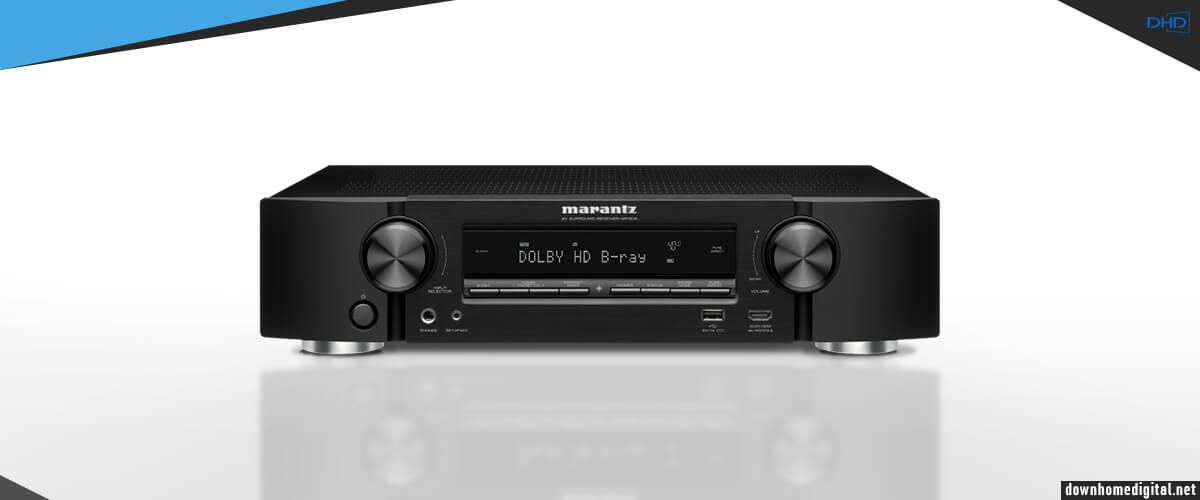
Marantz NR1510 appeared on the stage of AV receivers in 2019 and since then has won the hearts of cinema lovers and those users who like listening to high-quality music. It is advertised as “a receiver for a media room and a home theater”, and my plan was to check how well it copes with both tasks. This receiver may appeal to those who appreciate Marantz’s quality but don’t consider Dolby Atmos an advantage worth overpaying for. In other words, it is a cheaper alternative to the CINEMA 70s. The unit supports Dolby TrueHD and DTS-HD Master Audio decoders, so you can enjoy high-resolution multi-channel audio playback with perfectly defined low and high frequencies.
NR1510 represents the old line, where the LCD is normally shaped (well, sorry, my readers, I’m obsessed with LCD; it’s important for me to see what’s going on). The buttons are not the most convenient and small; they are located right under the screen, and I constantly touch them. After all, this is a receiver belonging to the budget category but still from the most prestigious brand. That’s why the anti-resonance is not bad (but with its power, there is no need for a fifth leg and a double bottom). Everything is generally stable, reliable, and works perfectly; the regulators are very sensitive and quite tight, which is nice.

This model lags behind the leader of the selection in the video, as it is a 6/1 HDMI with support for 4K resolution. But they have HDCP 2.3 protection and eARC features. But I’d like to highlight how well the source switching works (a rarity for budget models). The picture is stable, intense, and saturated colors are rendered very clearly, and the picture works with the sound with exceptional synchronicity.
The manufacturer states that the NR1510 is a 5.1-channel receiver with 50 watts (at 8 ohms) and 100 watts (at 8 Ohms) per channel. I believe this is a good variant for boosting any home theater system and frankly speaking, I was astonished at how crisp audio was while I was watching the movie. It seemed that shooting and fights took place right in my studio. In fact, the only difference with CINEMA 70s is the number of channels, which makes the overall soundstage not so rich. And you don’t have upper channels, even in virtual formats.
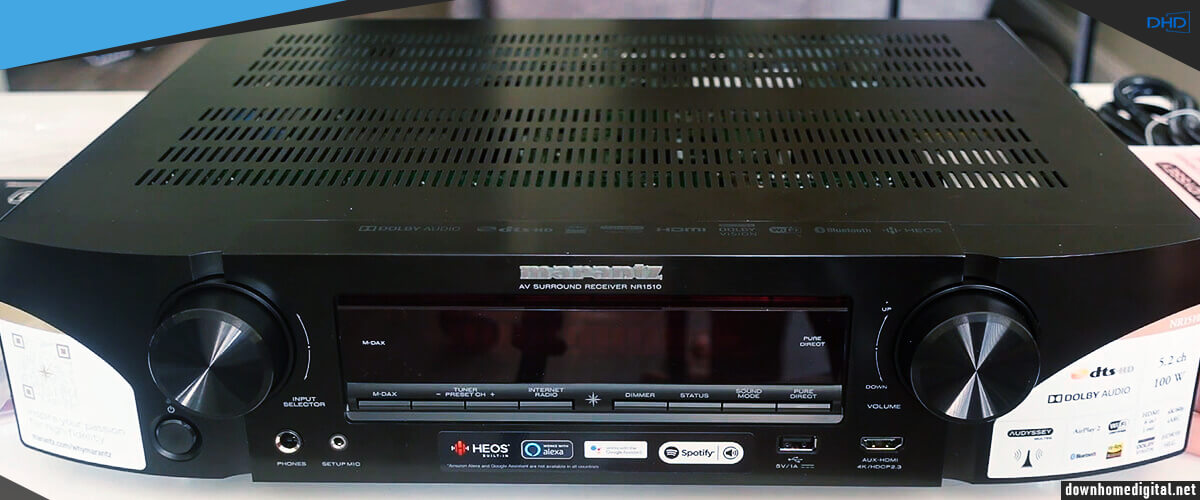
Just like the CINEMA 70s – this receiver is versatile, and you can listen to high-quality music. The Marantz NR1510 receiver is compatible with HEOS technology, allowing you to control the unit with any HEOS-compatible device for a great listening experience. You can also save TuneIn stations to your HEOS Favorites. Thanks to built-in Wi-Fi (dual-band), Bluetooth, and AirPlay, wireless connectivity is provided. This makes it more attractive than the Sony STR-DH590, as the latter only offers Bluetooth. Even though it’s a minor advantage, having a wider choice is always nice. It’s not the most important thing, but since we’re talking about pros and cons, if you decide to listen to music from a USB drive, there’s no Shuffle option for it.
Another thing I like about this model is its space-saving design. With the size of 17.3 x 14.8 x 4.1 inches/43.1 x 35.5 x 10.1 centimeters, it can be easily arranged on a shelf, a stand, etc.
So, the small 5.1 receiver Marantz NR1510 is something between the most expensive CINEMA 70s and the cheapest Sony STR-DH590. You have the advantages of the former’s build structure and warm, even sound, as well as wireless features, and only 5 channels of amplification and 4K video like the latter. And if the choice were up to me, I would prefer this particular model. But I’m not at the mercy of your finances, although honestly, it’s not so high priced that it’s not worth every penny spent.
It may not be the most advanced, and it may not support Dolby Atmos, but if you’re not obsessed with “bells and bells”, it’s a decent choice.
| Power |
|
| HDMI features |
|
| Video features |
|
| Network |
|
| Surround sound processing |
|
| Channels | 5.2 |
| Stereo power (RMS), W/Ohm | 50/8, 60/6 |
| Output impedance, Ohm | 8, 6 |
| Frequency response | 10Hz-100KHz |
| THD in stereo, % | 0.08 |
| Digital to analog converter (DAC) | 192 KHz/32-bit |
| Bi-amping | no |
| Pure direct (straight) | yes |
| Auto speaker calibration | Audyssey MultEQ |
| Speaker A/B switching | no |
| Other audio features | Audyssey Dynamic Volume, Audyssey Dynamic EQ, Compressed Audio Enhancer, Hi-Res audio |
| Wi-Fi | 2.4/5GHz |
| USB | 1 (USB 2.0) |
| Bluetooth | yes |
| Ethernet (RJ45) | 1 |
| DLNA | no |
| MHL | no |
| Apple Music (AirPlay) | AirPlay, AirPlay 2 |
| Amazon Music | yes |
| Spotify | yes |
| Other streaming services | Deezer, TIDAL, Pandora, Napster, SiriusXM, TuneIn Radio |
| HDMI input/output | 8/1 |
| HDMI ARC (Audio Return Channel) | yes |
| HDMI eARC (Enhanced Audio Return Channel) | yes |
| HDMI CEC | yes |
| Digital content protection (HDCP) | HDCP 2.3 |
| Subwoofer output (LFE) | 2 |
| Headphone output | 1 x 6.3 |
| Optical digital input | 1 |
| Coaxial digital input | 1 |
| Composite input | 3 |
| Component input/output | 2/1 |
| Phono (MM) input | yes |
| Front panel connectors | USB, HDMI, phones, setup mic |
| Multi channel preamp output | yes |
| HDR (High Dynamic Range) | HDR10 |
| 4K signal pass-through | 4K/60Hz |
| 8K signal pass-through | no |
| HDMI signal pass-through | yes |
| 3D signal pass-through | yes |
| HDMI pass-through in standby mode | yes |
| Video conversion | no |
| Analog to HDMI scaling | no |
| HDMI to HDMI scaling | no |
| Dolby Vision | yes |
| Other video features | HLG, BT.2020 |
| Voice control | Amazon Alexa, Google Assistant, Siri, Josh.AI |
| App control | iPhone, iPad, iPod, Android, Amazon Kindle |
| Display | colour OSD |
| Tuner | AM, FM |
| Sleep timer | yes |
| Auto power off | yes |
| ECO mode | yes |
| Graphical user interface (GUI) | yes |
| Setup assistant | yes |
| Firmware update | network, USB |
| Other additional features | IP Control, Web Control |
| Multi-room zones | has not |
| Zone audio output | has not |
| Zone HDMI output | has not |
| Multi-room control | has not |
| RS-232 | 0 |
| Remote control input/output (IR) | 1/0 |
| DC trigger output (12V) | 1 |
| Dolby Atmos | no |
| Dolby TrueHD | yes |
| Dolby Surround | no |
| Dolby (other) | Dolby Digital Plus |
| DTS:X | no |
| DTS HD Master | yes |
| DTS Virtual:X | no |
| DTS Neural:X | no |
| DTS (other) | DTS-ES, DTS 96/24, DTS-HD, DTS-EXPRESS, DTS-Surround, DTS-Neo:6 |
| Auro-3D | no |
| IMAX Enhanced | no |
| Multichannel stereo | yes |
| MP3 | yes |
| WMA | yes |
| AAC | yes |
| WAV | yes |
| FLAC | yes |
| ALAC | yes |
| Other audio file formats | has not |
| Operational power consumption, W | 180 |
| Standby consumption, W | 0.2 |
| Removable power cord | yes |
| Size W x H x D, cm/inches | 43.5 x 10.1 x 35.5/17 x 4.1 x 14.9 |
| Weight, kg/lbs | 8.1/18.1 |
| Release year | 2019 |
Pros
- Fast switching between video sources.
- Allows you to save TuneIn stations to your HEOS Favorites.
Cons
- Uncomfortable dashboard controls.
- Does not support 8K video.
- No Shuffle option when using a USB drive.
Best small stereo receivers
Marantz NR1200 – best stereo
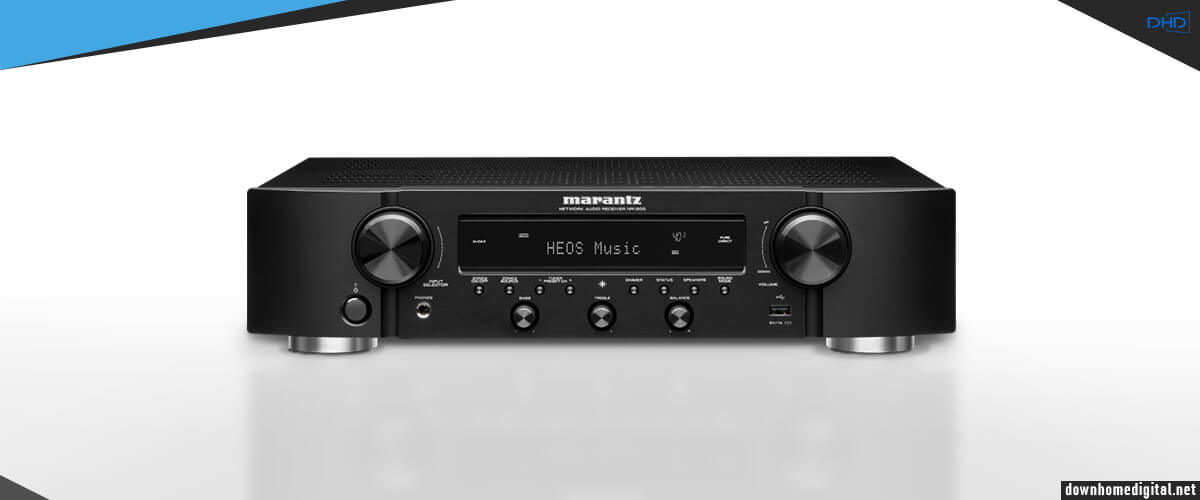
This chart is a kind of ode to the Marantz company. After all, NR1200 is already the third receiver of this brand on the list. But this time, we are talking about a 2-channel device, although it is a hybrid AVR, as it allows to broadcast 4K video (it has 5/1 HDMI ports). It should also be noted that this model is also, like the NR1711/1510 from my review, quite not young. It was released in 2019, but it is still popular among users (by the way, it is the only stereo receiver at Marantz today).
Even if I didn’t know this was a Marantz product, I would immediately grasp that because of the company’s recognizable design. It has a thick aluminum front panel with all the major controls logically arranged, so the setup process doesn’t take much time. As usual, the buttons are small, but there’s a full LCD and incredibly nice round controls of the same size that do an excellent job of finding the metric you need. Since we are again dealing with a slim receiver, the issue of heat dissipation is important. Here, we have the Eco Mode function, which reduces heat dissipation and power consumption without affecting the sound.
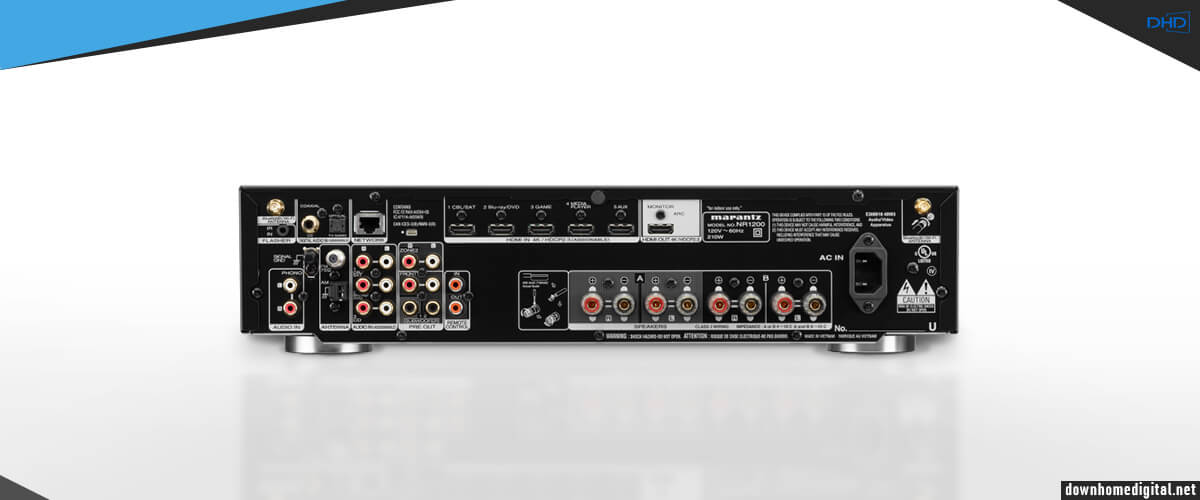
The size of this compact stereo receiver is identical to that of Marantz NR1711/1510 – 17.3 x 14.8 x 4.1 inches/43.1 x 35.5 x 10.1 cm. Thus, it is an excellent option for small- and medium-sized rooms. The power output of the unit is 75 watts per channel at 8 ohms and 150 watts at 6 Ohms.
This model is supplied with all the must-have digital inputs and outputs (5 HDMI inputs and one HDMI output for 4K video). Thanks to the built-in converter, the NR1200 can be used as an external DAC. Besides, you can connect 2 subwoofers. While listening to soundtracks from different sources, I got great sound every time. A built-in headphone amplifier with volume control was a pleasant surprise that allowed me to enjoy every music transition.
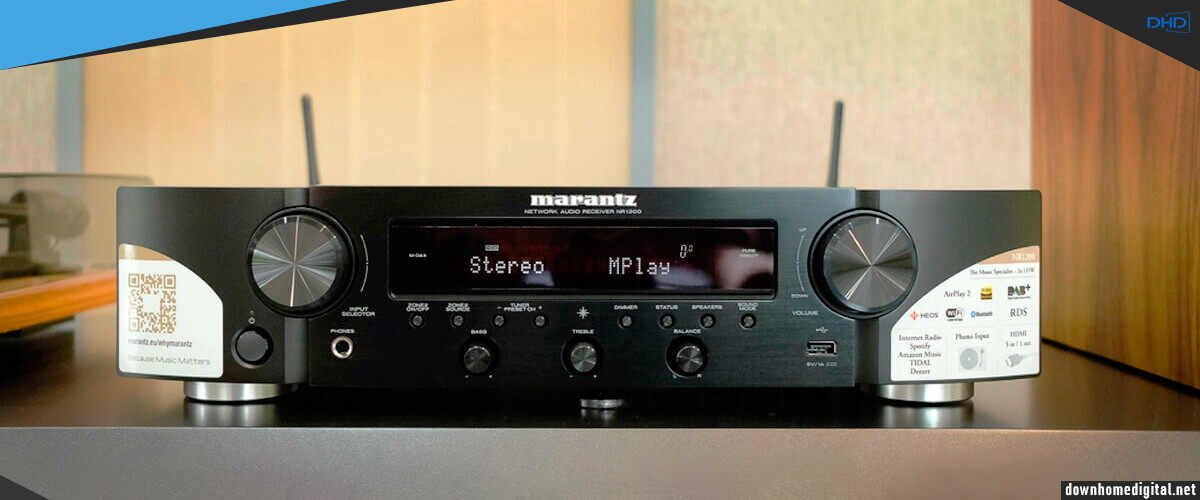
I used HEOS technology for instant access to Spotify Connect, Pandora, Amazon Music, and other music streaming services. Its video-sounding capabilities can’t compete with Marantz NR1711, but we can easily forgive this deficiency because this model is initially designed for music playback. Nevertheless, the NR1200 delivers pleasingly assertive high tones and smooth, well-resolved bass in a variety of genres.
Controlling is straightforward. I tried to switch modes and adjust settings using on-screen menus, a bundled remote control, and a dedicated app. Everything worked flawlessly. Unfortunately, it is impossible to change the volume of A and B speakers, but general customization can be made at the startup. However, the zone 2 pre-output can be set to variable or fixed in the GUI.
The Marantz NR1200 is ideal for those who love listening to quality music. Of course, it is not a professional studio amplifier. Still, for the average music lover, it will serve for a long time without losing sound quality, giving warm, realistic stereo digital and analog music. It fully meets the requirements for compact receivers, provides excellent sound, and is easy to operate and set up. At the same time, you get a bonus in the form of HDMI ports that allow the use of external sources for 4K resolution video, making this model a hybrid AVR. I can call the Marantz NR1200 the best small stereo receiver currently on the market.

